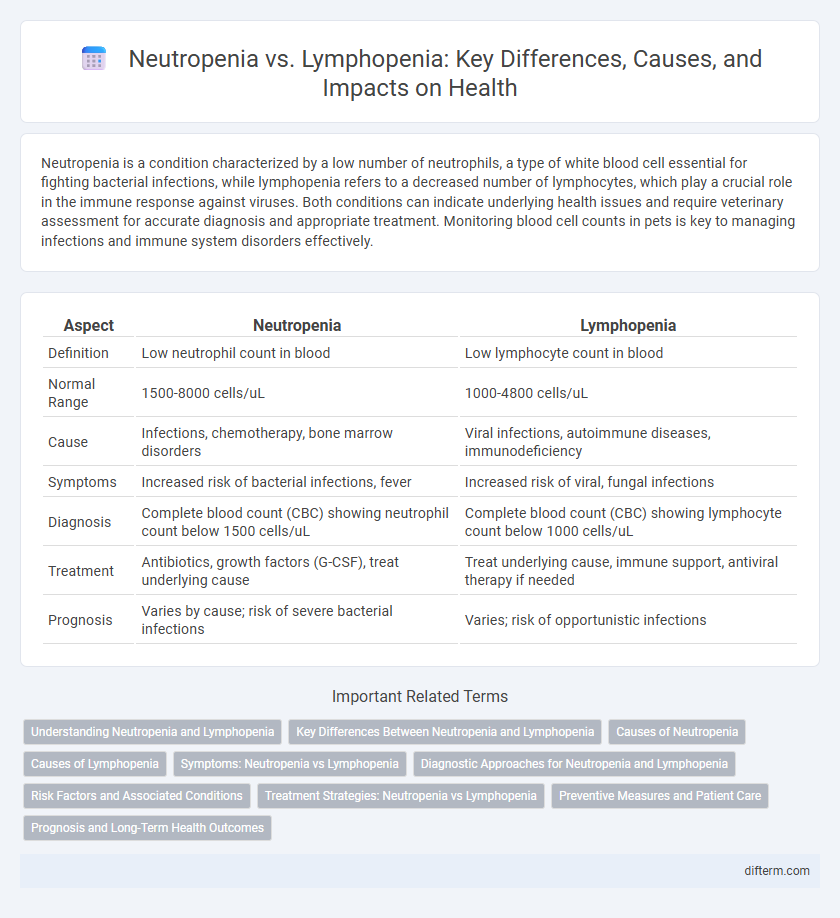Neutropenia is a condition characterized by a low number of neutrophils, a type of white blood cell essential for fighting bacterial infections, while lymphopenia refers to a decreased number of lymphocytes, which play a crucial role in the immune response against viruses. Both conditions can indicate underlying health issues and require veterinary assessment for accurate diagnosis and appropriate treatment. Monitoring blood cell counts in pets is key to managing infections and immune system disorders effectively.
Table of Comparison
| Aspect | Neutropenia | Lymphopenia |
|---|---|---|
| Definition | Low neutrophil count in blood | Low lymphocyte count in blood |
| Normal Range | 1500-8000 cells/uL | 1000-4800 cells/uL |
| Cause | Infections, chemotherapy, bone marrow disorders | Viral infections, autoimmune diseases, immunodeficiency |
| Symptoms | Increased risk of bacterial infections, fever | Increased risk of viral, fungal infections |
| Diagnosis | Complete blood count (CBC) showing neutrophil count below 1500 cells/uL | Complete blood count (CBC) showing lymphocyte count below 1000 cells/uL |
| Treatment | Antibiotics, growth factors (G-CSF), treat underlying cause | Treat underlying cause, immune support, antiviral therapy if needed |
| Prognosis | Varies by cause; risk of severe bacterial infections | Varies; risk of opportunistic infections |
Understanding Neutropenia and Lymphopenia
Neutropenia is characterized by an abnormally low count of neutrophils, a type of white blood cell crucial for fighting bacterial infections, while lymphopenia involves a reduced level of lymphocytes, key players in immune response against viruses and tumors. Accurate differentiation between neutropenia and lymphopenia is essential for diagnosing underlying conditions such as infections, autoimmune diseases, or hematologic disorders. Monitoring blood cell counts through complete blood count (CBC) tests supports targeted treatments and improves patient outcomes by addressing specific immune deficiencies.
Key Differences Between Neutropenia and Lymphopenia
Neutropenia is characterized by a decreased absolute neutrophil count, usually below 1,500 cells per microliter, increasing susceptibility to bacterial infections. Lymphopenia involves a reduced lymphocyte count, often under 1,000 cells per microliter, leading to impaired viral and fungal immunity. The primary distinction lies in the affected white blood cell subtype and the associated infection risks, with neutropenia predominantly linked to bacterial infections and lymphopenia to viral or opportunistic infections.
Causes of Neutropenia
Neutropenia is primarily caused by bone marrow suppression due to chemotherapy, radiation therapy, or infections such as viral hepatitis and sepsis. Autoimmune disorders like lupus and certain medications, including antibiotics and antithyroid drugs, also contribute to decreased neutrophil production. In contrast, lymphopenia results from HIV infection, corticosteroid use, or inherited immunodeficiencies, highlighting distinct etiologies between these two hematologic conditions.
Causes of Lymphopenia
Lymphopenia primarily results from conditions that impair lymphocyte production or increase their destruction, such as autoimmune diseases, HIV infection, corticosteroid therapy, or severe malnutrition. Viral infections and certain genetic disorders can also lead to significant reductions in lymphocyte counts. Understanding these causes is critical for diagnosing underlying immune system dysfunctions and tailoring appropriate treatments.
Symptoms: Neutropenia vs Lymphopenia
Neutropenia primarily presents with frequent bacterial infections, fever, and mouth sores due to a decreased neutrophil count affecting the body's ability to fight bacteria. Lymphopenia symptoms often include increased vulnerability to viral, fungal, and opportunistic infections, as lymphocytes are crucial for adaptive immunity. Both conditions can cause general signs of immune deficiency, but the type of infections and immune response deficits help differentiate neutropenia from lymphopenia.
Diagnostic Approaches for Neutropenia and Lymphopenia
Diagnostic approaches for neutropenia primarily involve complete blood counts (CBC) with differential to assess neutrophil levels, bone marrow biopsy in cases of severe or unexplained neutropenia, and screening for underlying infections or autoimmune disorders. Lymphopenia diagnosis includes CBC with differential to quantify lymphocyte subsets, flow cytometry for detailed immunophenotyping, and evaluation for viral infections such as HIV or immunodeficiency syndromes. Both conditions require comprehensive clinical assessment and may involve additional tests like vitamin B12 levels, immunoglobulin profiling, and imaging studies to identify associated causes.
Risk Factors and Associated Conditions
Neutropenia commonly arises from chemotherapy, bone marrow disorders, and autoimmune diseases, increasing susceptibility to bacterial infections. Lymphopenia is often linked to viral infections, immunodeficiency states such as HIV/AIDS, and corticosteroid use, leading to higher risks of viral and opportunistic infections. Both conditions signify underlying immune dysfunction, requiring tailored diagnostic evaluation for accurate identification of associated hematologic and systemic diseases.
Treatment Strategies: Neutropenia vs Lymphopenia
Treatment strategies for neutropenia primarily involve addressing the underlying cause, administering granulocyte colony-stimulating factor (G-CSF), and implementing infection prophylaxis to reduce morbidity. In contrast, lymphopenia management centers on treating underlying diseases, supplementing with immunoglobulins in severe cases, and monitoring for opportunistic infections due to compromised adaptive immunity. Both conditions require tailored therapeutic approaches based on the severity and etiology to optimize patient outcomes.
Preventive Measures and Patient Care
Preventive measures for neutropenia include minimizing exposure to infectious agents through strict hygiene protocols and administering prophylactic antibiotics or growth factors like G-CSF to boost white blood cell counts. For lymphopenia, enhancing immune function with adequate nutrition, vaccination against common infections, and monitoring for opportunistic infections are crucial patient care strategies. Both conditions require regular blood count monitoring and prompt treatment of any infections to prevent complications and improve patient outcomes.
Prognosis and Long-Term Health Outcomes
Neutropenia, characterized by a decreased neutrophil count, often leads to increased susceptibility to bacterial infections, influencing short-term prognosis but can be reversible with appropriate treatment, resulting in generally favorable long-term outcomes if managed effectively. Lymphopenia, defined by low lymphocyte levels, is frequently associated with chronic immune dysfunction and can indicate underlying conditions such as HIV or autoimmune diseases, leading to more variable long-term health outcomes with potential for persistent immunodeficiency. Prognostic assessments for both conditions depend on underlying causes, severity, and response to treatment, with long-term monitoring essential to mitigate infection risks and guide therapeutic strategies.
Neutropenia vs Lymphopenia Infographic

 difterm.com
difterm.com